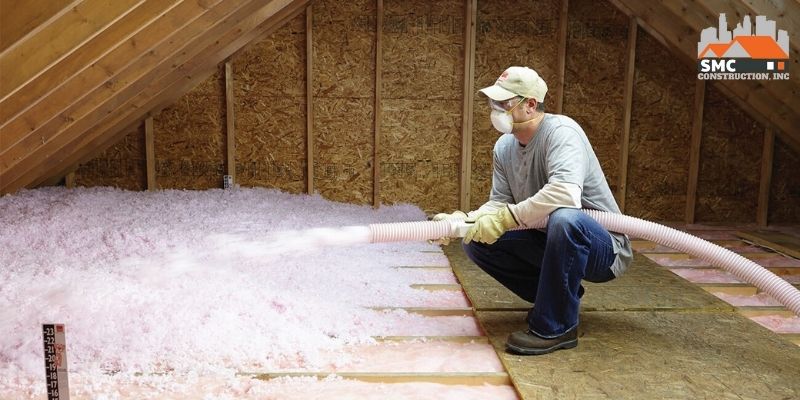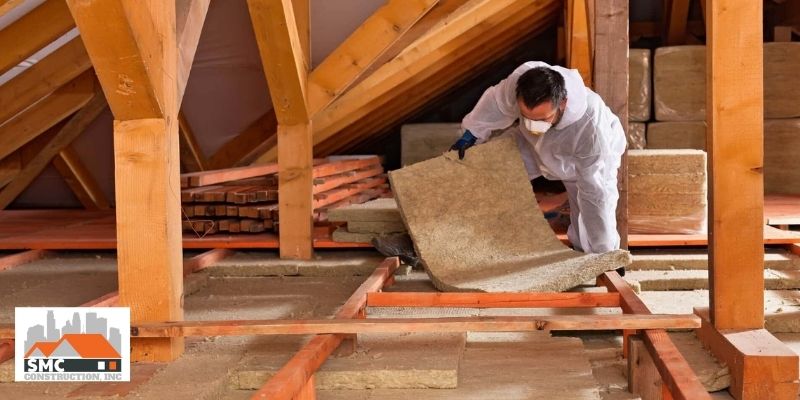You need proper attic installation to retain cool air in the summer and prevent heat loss in the winter. In addition to good installation, using the right insulation material is important. Therefore, you should pay attention to what is happening in your attic.
Types Of Attic Insulation

There are different types of attic insulation available in today’s market. The most popular ones include blankets, foam board, radiant foil, and spray foam. Each of these has benefits and shortcomings.
Let’s look at them one at a time…
Blanket insulation
This is one of the most common insulation types for attic floors and walls. However, it should not be used in open spaces, as the fiberglass in the blanket material can negatively affect the air quality of your home. You should be sure that the insulation is well-cut to tightly fit around wires, pipes, and in between gaps in wooden frames.
The installation of blanket insulation is easy and not expensive. However, it is not as efficient as spray foam insulation. You should always wear protective glasses and a breathing mask when installing blanket insulation. This is to avoid irritating your eyes, skin, and lungs.
Spray foam insulation
Another type of attic insulation is spray foam insulation. When paired with blanket insulation, it will better insulate corners and edges. It can also be used to seal gaps in existing walls. Spray foam insulation is the most effective option to use for insulating your attic against cold and hot air transmission. However, spray foam is the most expensive of all types of attic insulation. Also, removing it can be a hassle. Made of liquid polyurethane, spray foam expands when sprayed into your attic or wall cavity and hardens to solid foam. Consider hiring a professional if you have not used spray foam before to ensure that your home is well-protected.
Radiant foil
Radiant foil is primarily designed to reflect heat from your home. For this reason, it is common in homes in warmer climates. It is through the reflective foil barrier that this type of attic material works. This barrier is attached to polyethylene bubbles or kraft paper. The bubble provides a pocket of air, therefore preventing the transfer of heat through the barrier. The bubble also reduces the amount of heat that can move through the substance.
While radiant foil reflects the flow of heat, standard insulation reduces it. Due to this difference, the same factors attributed to foam board, spray, or blanket insulation cannot be used to measure radiant foil. Radiant foil is an affordable type of insulation.
Foamboard
Foam board insulation is made of polyisocyanurate, polystyrene, or polyurethane. It is inexpensive and easy to install. The sheets of the foam board can be cut to tightly fit between attic ceiling joist or wall studs. Foam boards are not as popular as blanket insulation because they are not as effective at insulating.
Unlike blanket insulation, there are no issues of mold growth or moisture accumulation with foam boards. This is because the solid foam absorbs very little moisture. It dries within a short time frame.
How To Choose The Right Attic Insulation Material

It is necessary to add attic insulation to your home in most circumstances. However, installing insulation can cause a few problems. For example, older homes with large gaps between the walls can be damaged when insulated. This is because filling the spaces with insulation can lead to rotted wood and mold due to moisture absorption. Additionally, the makeup of older roofing materials ensures that they get wet, breath,e and dry. However, moisture will only accumulate with insulation blocking the wood. You should also avoid using insulation close to tube wiring and knobs. Tube wiring is an outdated electrical system that is at risk of causing a major fire.
Below are things to consider when choosing the right insulation materials for your situation…
1. R-value
The effectiveness of each attic insulation material differs. For this reason, the R-value of the insulation material is used as a measuring tool. The R-value is a measurement of a material’s insulation to heat flow. If the R-rating of a product is higher, it means that it will be very effective at reducing energy costs in your home.
You can always find the R-rating listed on the product packaging or product description. However, there is no R-value measurement for foil insulation because it is designed to reflect heat rather than reduce its transmission. Additionally, the geographical location of your home determines its optimal R-value for the insulation.
2. Condition of your attic
Knowing the condition of your attic will help you make the right choice when choosing an insulation material. You should know if your attic is finished or unfinished. You will have a variety of options to select from if you have an unfinished attic. In contrast, your options may be limited if your attic is finished. In this case, an insulation contractor can recommend the best attic insulation material for your particular home. One such recommendation is to use a blown-in insulation product. This product is a solution that will fill any crevices. It is an excellent solution for crawl spaces and other hard-to-reach places.
3. Material
The material that makes up the insulation is another factor to consider. Insulation is made of a wide variety of materials including polystyrene, liquid polyurethane, mineral wool, fiberglass, and cellulose. Polystyrene is used to make foam board insulation. Its R-value is between 3.8 and 5.0 per inch.
The R-value for liquid polyurethane ranges from 3.5 to 6.6 per inch. For mineral wool, the R-value is 3.3 per inch. Fiberglass with an R-value of 2.7 per inch is used in making blanket insulation. Cellulose has a relatively low R-value at 3.8 per inch.
Conclusion
Attic insulation is important for modern homes. You should understand the various types of attic materials and their suitability to your particular climate. When considering the type of insulation to get for your home, make sure that you consider the condition of your attic, the material the insulation is made of, and the R-value of the material. If you need help regarding the material choice that’s best for you, talk with the experts at SMC Construction. For more information, please call SMC Construction at 763-400-0251.

